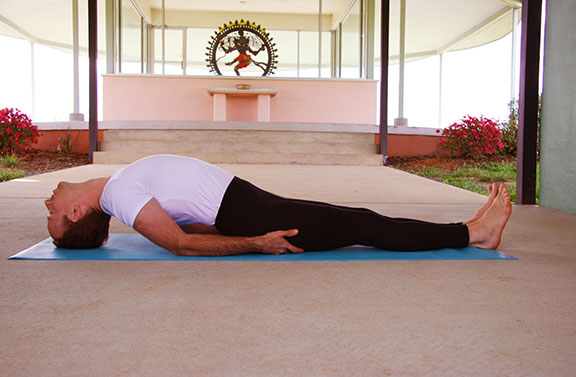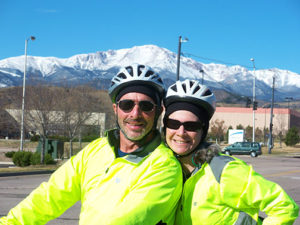 Introduction
Introduction
I was inspired to write this article after reading Tracy Cooley’s excellent Integral Yoga Magazine article. She describes running a 108 kilometer distance. Certainly, an incredible accomplishment, particularly as a Yoga meditation.
I love to swim. Swimming is not quite as vigorous as running, but it does provide an opportunity for meditation. I will describe swimming 108 lengths of the pool. But first, here is the description of the Hatha Yoga pose, matsyasana.
(Photo: Barry Siva Wick)
Matsyasana

Matsyasana, the Fish Pose (demonstrated at Satchidananda Ashram–Yogaville, Virginia)
The fish pose is a back-bending Yoga posture that opens the chest, throat, and abdomen. The fish pose offers a deep stretch for the shoulders, chest, and the front body, including the throat, abdomen, and hip flexors. The pose also strengthens the musculature of the back and neck, encourages better breathing, and can help relieve spinal tension and improve posture. It is said that practicing the fish pose on water allows the body to float effortlessly.
Lifelong Swimming
Every morning I look for my obituary. If I don’t see it, I get up and go swimming. I’m in my 70s. I’ve been swimming for over 60 years. I’ve been practicing Yoga for over 50 years. I’ve been meditating for over 50 years. This is a long time to be involved with anything!
I’m a good swimmer. I can swim forever. But, actually, I’m a terrible meditator. Even after years of practice, I still space out. I keep thinking about Duke basketball. I’ve tried mantra, pranayama, Zen, shikantaza, koan, mandala, mala beads, watching my breath while sitting. I still daydream about playing for Coach K. I’m the oldest and shortest member of the team, yet I hit the winning 3-point basket to win the National Championship. And I do this every time I meditate! I’m really more of a Karma Yogi— meditation through action and service. I can do that forever too. Just not sitting and counting breaths!
I’ve been swimming since I was 6, having learned to swim at the Elks Club in Phoenix. All of us siblings competed as kids on the Phoenix Jewish Community Center swim team. That’s over 60 years of swimming laps. I’m now considered a senior swimmer. That’s a special category of master swimmers.
A note of clarification: most standard swimming pools are 25 yards in length. A lap is two lengths, or up and back in the pool. Some competitive pools, such as the Olympic Training Center in Colorado Springs are 50 meters in length. That’s slightly more than two 25 yard lengths. So, 108 lengths in a standard 25 yard pool would be over a mile. Over the years, I have swum from Colorado to Virginia (home of Satchidananda Ashram–Yogaville) and back—at least 5000 miles!
Swimming and Meditation
So how can swimming become a meditative practice? Tracy Coleman focuses on running and meditation. Here are some parallels. I try to do 108 lengths every morning. That takes me about an hour. Not quite the ultra-running of Tracy, but more manageable for me than sitting on a cushion in full lotus for an hour. When I lived at the Integral Yoga Institute in New York in 1968, we (well, some of us!) got up at 5:00 am for group meditation. It always amazed me that Richard Shankar Shrobe (now Wu Kwang Soen Sa Nim, head teacher at Chogye International Zen Center of New York) was so still and focused, while I was off in space. I tried! (It was also quite trying!) Now I get up at 5:00 am to swim.
But I digress. Back to the swimming. Some people are bored by swimming laps. Some people are bored and start to doze while sitting too. Not me. I could do this forever. The regular breathing and movement are meditative. It’s natural. Like a mantra or a koan, but in the water. Feel the water. Ten breaths. Turn. Start over. Ten breaths. Turn. Start over. Feel the water. Soon I’m in another place. Not on the basketball court. Not in the pool. Not anywhere. Who is it that is swimming, breathing, stroking, feeling the water? Not me. There is no me. Just the motion, the breathing. I’ve become like a fish, moving effortlessly, as aqua dynamic as possible. A fish doesn’t think that it is in the water. It just is.
During every length, I increment my count. I don’t count my breaths. I only count the lengths. I breathe on both sides for freestyle. Right side up. Left side coming back. Right side up. Left side coming back. Count the length, not the breath. Inhale and count. Exhale in the water. Inhale and count. Exhale in the water. A meditative experience in motion. Soon I’ve counted to 108.
That’s in the pool. In some ways it is easier in open water, like a lake. There are no lane lines. There are no constraints. Just a starting point and an ending point. Maybe these are actually the same? Is there a starting point and an ending point? Is there a distinction between meditator and meditation? Is there a distinction between swimmer and swimming? It just is.
Yes. The swim session does end. Just as the NY IYI morning meditation ended. Shankar rings the bell. We all stretch and get up and proceed with our daily activities. And I still shoot the winning basket.
Blind Swimming
My wife is blind, yet she swims too. How? This is also a meditative process. She counts her strokes, reaches for the end of the pool, and turns. She does the same with the next length. Counts her strokes, reaches for the end, and turns. It’s all counting. And she is counting lengths at the same time. Just like counting breaths on the meditation mat, only in the water, always moving.
Hydration and Diet
As with any physical activity, hydration and diet are important. You may not realize it, but you are perspiring as you swim. It is as important to be drinking during the workout, just as with running or any other physical activity.
Diet is important too. I’m a lifelong vegetarian. I include kale, agave, tofu, Quorn, and quinoa in my diet. But I also think about pizza and Haagen-Dazs when I meditate! Not when I swim. It’s just swimming.
Why Swim?
What are the benefits of swimming? Swimming is another popular physical activity. One major advantage is that there is no impact on the joints. The body is horizontal. We are working our entire cardiovascular system and our muscular system. We don’t need to do just freestyle, the most common swimming stroke, but we can vary the stroke to include backstroke, breaststroke, butterfly, and others. Swimming has been demonstrated to help with the aging process. There is a competitive women’s relay team in Florida, composed of 90 year olds! Nonagenarians rock!
Swimming can easily be combined with stretching and Yoga. There are aqua physical therapy and aquatic Yoga too. So, there are lots and lots of benefits.
Inspiring Quotes to Encourage a Daily Swim Routine
“To have faith is to trust yourself to the water. When you swim, you don’t grab hold of the water, because if you do, you will sink and drown. Instead you relax and float.” –Alan Watts, American-British philosopher
“I actually love swimming, but I just hate jumping in the water.” —Natalie Coughlin, American Olympic swimmer
“Do activities you’re passionate about—which make your heart and soul feel perky—including things like working out, cooking, paining, writing, Yoga, hiking, walking, swimming, being in nature, being around art, or reading inspiring books.” —Karen Saimansohn, American author
“The best swimmers are the ones that almost don’t try the most… It’s just about relaxing and enjoying it.” —Cate Campbell, Australian athlete
“So this is how you swim inward. So this is how you flow outwards. So this is how you pray.” —Mary Oliver, American poet
“Swimming laps is mindless. Yes! That’s the whole point!” Siva Wick, the “elder” Barry
References
- How to be Mindful While Swimming
https://www.nytimes.com/2017/05/24/well/mind/how-to-be-mindful-while-swimming.html
- What is Swimming Meditation?
https://mindworks.org/blog/what-is-swimming-meditation/
- 4 Tips for Turning Swimming into a Moving Meditation
https://www.gaia.com/article/4-tips-turning-swimming-moving-meditation
- The meditative power of swimming
https://www.psychologies.co.uk/self/the-meditative-power-of-swimming.html
- Zen and the art of swimming
https://www.thespec.com/living-story/2210074-zen-and-the-art-of-swimming/
- Swim: Why We Love the Water by Lynn Sherr https://www.amazon.com/Swim-Why-We-Love-Water/dp/1610393333
- The Joy of Swimming by Lisa Congdon and Lynne Cox https://www.amazon.com/Joy-Swimming-Celebration-Getting-Water/dp/1452144133
About the Author:
 Barry Siva Wick lived and served (including as executive director) at the Integral Yoga Institute from 1968 to 1972. He, his then-wife Padma, and Kumar Kramer organized the first Integral Yoga retreat at Annhurst College in Connecticut. The success of this retreat inspired many more retreats that continue to present day at Satchidananda Ashram–Yogaville and other Integral Yoga centers.
Barry Siva Wick lived and served (including as executive director) at the Integral Yoga Institute from 1968 to 1972. He, his then-wife Padma, and Kumar Kramer organized the first Integral Yoga retreat at Annhurst College in Connecticut. The success of this retreat inspired many more retreats that continue to present day at Satchidananda Ashram–Yogaville and other Integral Yoga centers.
After leaving New York for Seattle in 1972, he and Padma organized a number of programs for Swami Satchidananda, including a retreat on Orcas Island and “Unity in Diversity,” an interfaith symposium. Although raised Jewish, Siva studied both Yoga and Zen for many years. His brother is a Zen teacher and has a center near Boulder, the Great Mountain Zen Center. Siva and Padma were blessed to host visits for Brother David, Rebbe Zalman Schachter, Prabhasa Dharma (Gesshin) Roshi, and Mother Tessa Bielecki over the years.
Siva had a long career as an engineer and he taught math and served in the Peace Corps in Africa when he was 60. He met Marcia, his current partner, quite literally, on a blind date—she is a blind skier. Together they maintain a very active lifestyle, enjoying biking, hiking, skiing, and doing triathlons. Siva says, “Gurudev’s simple teaching, ‘Easeful, Peaceful, Useful’ stays with me constantly.” (photo: Barry and Marcia out for a ride on their tandem bicycle with snow-covered Pikes Peak in the background.)

